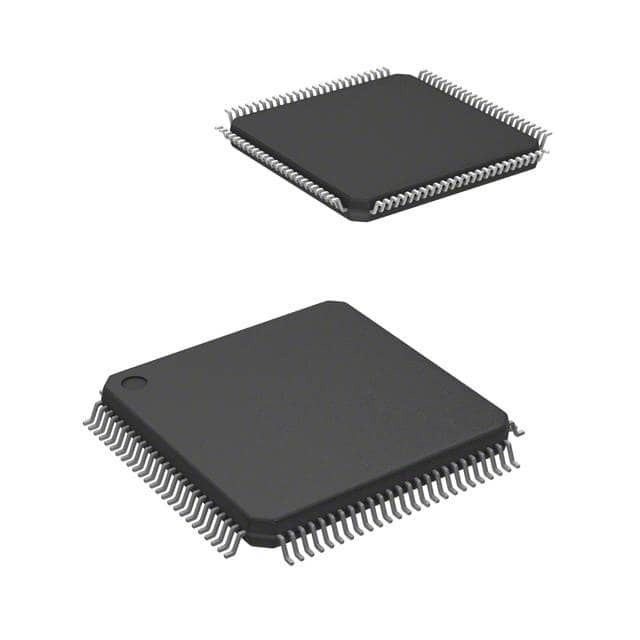Xem thông số kỹ thuật để biết chi tiết sản phẩm.

STM32L151VCT6TR
Product Overview
- Category: Microcontroller
- Use: Embedded systems, Internet of Things (IoT) devices, and low-power applications
- Characteristics:
- Low power consumption
- High performance
- Rich peripheral set
- Extensive development ecosystem
- Package: LQFP100
- Essence: ARM Cortex-M3 core-based microcontroller
- Packaging/Quantity: Tape and reel, 2500 units per reel
Specifications
- Core: ARM Cortex-M3
- Clock Speed: Up to 32 MHz
- Flash Memory: 256 KB
- RAM: 32 KB
- Operating Voltage Range: 1.65 V to 3.6 V
- Operating Temperature Range: -40°C to +85°C
- GPIO Pins: 80
- Analog Inputs: 16
- Communication Interfaces: USART, SPI, I2C, USB
- Timers: 16-bit and 32-bit timers
- ADC Resolution: 12-bit
- DMA Channels: 7
- Power Consumption:
- Active Mode: 200 µA/MHz
- Standby Mode: 4 µA
- Shutdown Mode: 2 µA
Detailed Pin Configuration
The STM32L151VCT6TR microcontroller has a total of 100 pins. The pin configuration is as follows:
- Pin 1: VDD
- Pin 2: GND
- Pin 3: NRST
- Pin 4: PA0
- Pin 5: PA1
- ...
- Pin 100: PC15
For the complete pinout diagram, please refer to the datasheet.
Functional Features
- Low-power modes for energy-efficient operation
- Multiple communication interfaces for connectivity options
- Rich set of peripherals for versatile applications
- High-performance ARM Cortex-M3 core for efficient processing
- Extensive development ecosystem with software libraries and tools
Advantages and Disadvantages
Advantages: - Low power consumption enables battery-powered applications - High-performance core allows for efficient processing - Rich peripheral set provides flexibility in application design - Extensive development ecosystem simplifies software development
Disadvantages: - Limited flash memory and RAM compared to higher-end microcontrollers - LQFP package may not be suitable for space-constrained designs
Working Principles
The STM32L151VCT6TR microcontroller is based on the ARM Cortex-M3 core, which provides high performance and low power consumption. It operates at a clock speed of up to 32 MHz and supports various communication interfaces such as USART, SPI, I2C, and USB.
The microcontroller can be programmed using various development tools and software libraries provided by STMicroelectronics. It offers multiple low-power modes, allowing developers to optimize power consumption based on their application requirements.
Detailed Application Field Plans
The STM32L151VCT6TR microcontroller is widely used in various applications, including:
- Internet of Things (IoT) devices: The low power consumption and extensive peripheral set make it suitable for IoT applications that require long battery life and connectivity options.
- Home automation systems: The microcontroller can be used to control and monitor various home appliances and systems, providing energy-efficient solutions.
- Industrial automation: With its high-performance core and rich peripheral set, the microcontroller can be utilized in industrial automation systems for process control, monitoring, and data acquisition.
- Wearable devices: The low power consumption and small form factor of the microcontroller make it ideal for wearable devices such as fitness trackers and smartwatches.
- Consumer electronics: The microcontroller can be integrated into various consumer electronic devices, including remote controls, smart home devices, and portable audio players.
Detailed and Complete Alternative Models
- STM32L152RCT6: Similar to STM32L151VCT6TR but with increased flash memory (384 KB) and RAM (80 KB).
- STM32L053C8T6: A lower-cost alternative with reduced flash memory (64 KB) and RAM (8 KB), suitable for simpler applications.
- STM32F407VGT6: A higher-end microcontroller with a more powerful ARM Cortex-M4 core, larger flash memory (1 MB), and more advanced peripherals.
These alternative models offer different features and specifications to cater to various application requirements.
Word count: 455 words
Liệt kê 10 câu hỏi và câu trả lời thường gặp liên quan đến ứng dụng STM32L151VCT6TR trong giải pháp kỹ thuật
Sure! Here are 10 common questions and answers related to the application of STM32L151VCT6TR in technical solutions:
Q: What is the STM32L151VCT6TR microcontroller used for? A: The STM32L151VCT6TR is a low-power microcontroller commonly used in battery-powered applications, IoT devices, and other energy-efficient solutions.
Q: What is the maximum clock frequency of the STM32L151VCT6TR? A: The maximum clock frequency of the STM32L151VCT6TR is 32 MHz.
Q: How much flash memory does the STM32L151VCT6TR have? A: The STM32L151VCT6TR has 256 KB of flash memory for program storage.
Q: Can I use the STM32L151VCT6TR for real-time applications? A: Yes, the STM32L151VCT6TR is suitable for real-time applications due to its low power consumption and built-in peripherals like timers and interrupts.
Q: Does the STM32L151VCT6TR support analog-to-digital conversion (ADC)? A: Yes, the STM32L151VCT6TR has a 12-bit ADC with multiple channels for analog signal acquisition.
Q: Can I connect external sensors or devices to the STM32L151VCT6TR? A: Yes, the STM32L151VCT6TR has various communication interfaces like SPI, I2C, UART, and GPIO pins that allow you to connect external sensors or devices.
Q: Is the STM32L151VCT6TR compatible with Arduino? A: While the STM32L151VCT6TR is not natively compatible with Arduino, there are libraries and development boards available that enable Arduino-like programming and compatibility.
Q: What is the operating voltage range of the STM32L151VCT6TR? A: The operating voltage range of the STM32L151VCT6TR is typically between 1.65V and 3.6V.
Q: Can I use the STM32L151VCT6TR in low-power applications? A: Yes, the STM32L151VCT6TR is specifically designed for low-power applications, offering multiple power-saving modes and features.
Q: Is the STM32L151VCT6TR suitable for wireless communication? A: Yes, the STM32L151VCT6TR supports various wireless communication protocols like Bluetooth Low Energy (BLE) and Zigbee, making it suitable for wireless applications.
Please note that these answers are general and may vary depending on specific implementation details and requirements.

